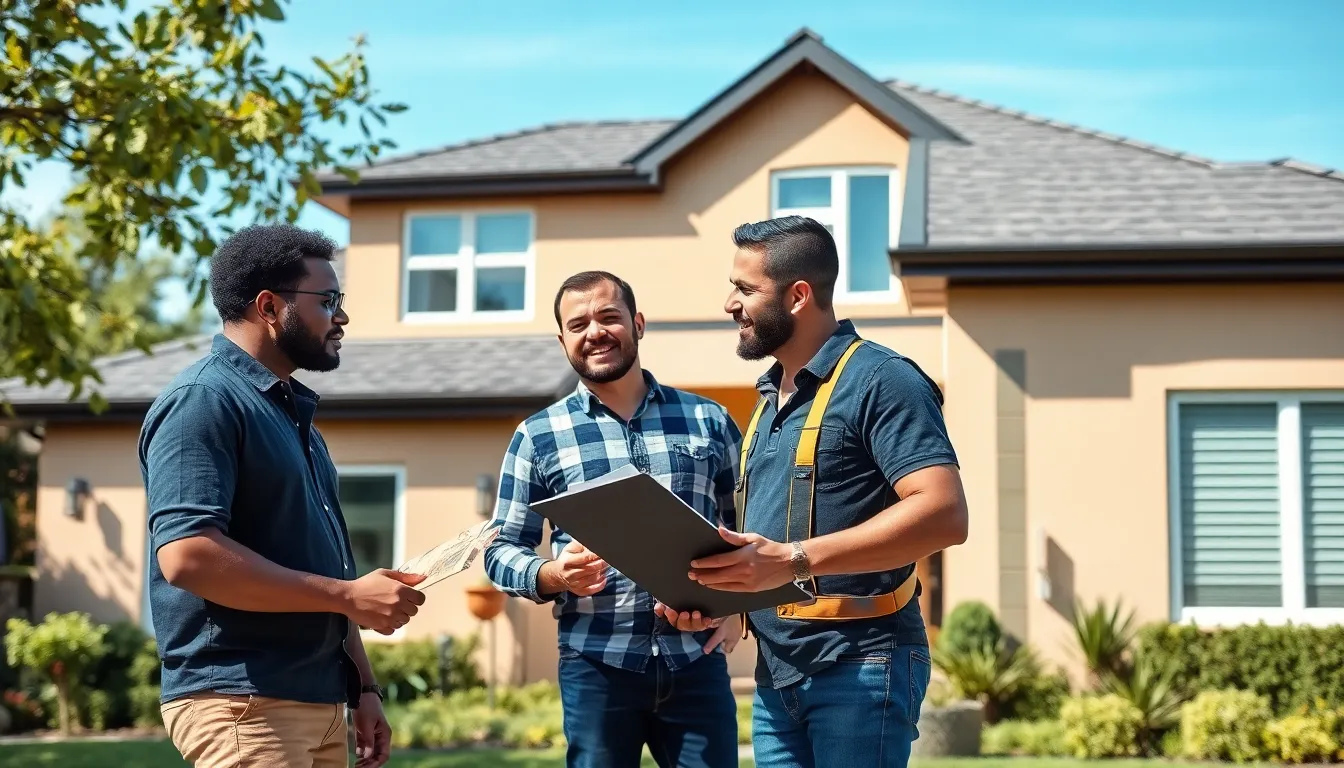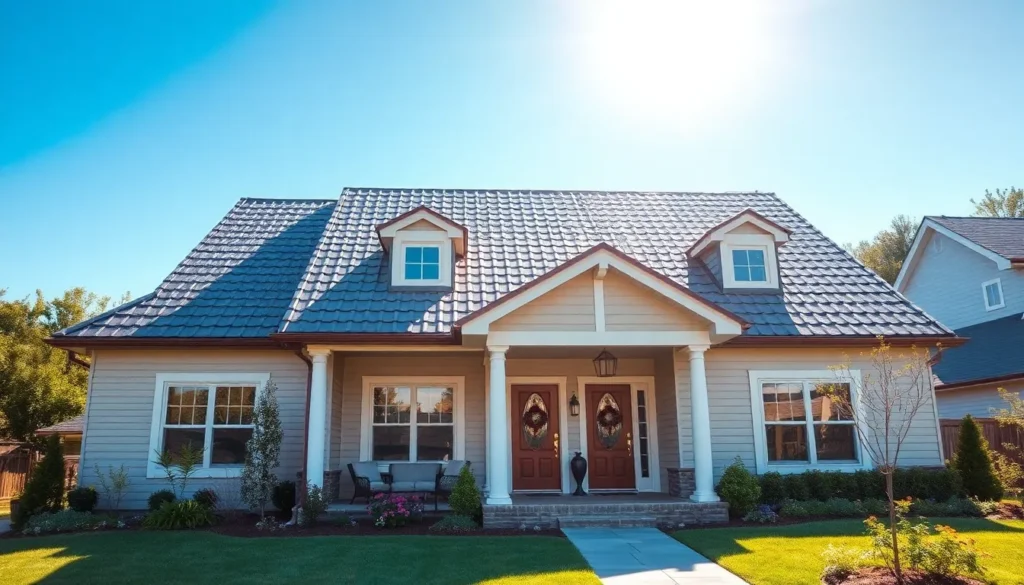Table of Contents
ToggleEver found yourself staring at your roof, thinking it could use a little makeover? Let’s be honest, roofs don’t generate as much excitement as, say, a new car or the latest smartphone. But, choosing the right roofing material is pivotal, and vinyl roofing has been turning heads. Why? Because it’s durable, relatively affordable, and yes, it can make your house look just as snazzy as that new car on the lot. So grab a cup of coffee, kick back, and let’s explore everything you need to know about vinyl roofing, from its benefits to installation tips. Your roof is about to have its moment in the sun.
Understanding Vinyl Roofing

Vinyl roofing, often made from polyvinyl chloride (PVC), is a synthetic option that’s rapidly gaining traction among homeowners. Unlike traditional materials like asphalt or wood shingles, vinyl adds a modern flair and boasts impressive resilience against the elements. In fact, its waterproof qualities make it a prime choice for areas prone to heavy rain or snow. This roofing is designed to mimic the look of more expensive materials while delivering outstanding performance.
Also, vinyl roofing comes in a variety of styles and colors, allowing homeowners to customize their roofs to fit the aesthetic of their homes. Whether you’re a fan of a classic appearance or something more contemporary, there’s likely a vinyl option that will meet your needs.
It’s also worth mentioning that the lightweight nature of vinyl roofing simplifies installation. This means your contractor can have it up and running without dealing with heavy lifting, making the entire process smoother and faster.
Benefits of Vinyl Roofing
Why should homeowners consider vinyl roofing, you ask? Let’s break down the benefits:
- Cost-Effective: Vinyl roofing typically comes at a lower price point than traditional materials. It’s fantastic for those looking to save some dollars without sacrificing quality.
- Durability: This roofing can withstand harsh weather, including UV exposure and unpredictable storms. Say goodbye to the hassle of frequent replacements and repairs.
- Low Maintenance: With vinyl, a simple rinse with a garden hose is often all it takes to keep your roof looking great.
- Energy Efficiency: Many vinyl roofing products are designed with energy efficiency in mind, helping keep your home cooler in the summer and warmer in the winter.
- Variety: As mentioned, vinyl roofing comes in multiple styles and colors, allowing homeowners to reflect their individuality in their home’s design.
Summarizing, from durability to cost-effectiveness, vinyl roofing brings a host of advantages that can appeal to any homeowner.
Vinyl Roofing Installation Process
The process of installing vinyl roofing generally follows a straightforward path, making it an attractive choice for homeowners eager for a quick upgrade:
- Preparation: Before installation, the existing roofing material will need to be removed. This involves careful handling to ensure that the underlying structure remains intact.
- Inspection: Once stripped down, the roof deck is inspected for any signs of damage that need to be addressed.
- Underlayment Installation: A protective layer is installed to create a barrier against moisture.
- Vinyl Panels: The real fun begins here. The vinyl panels are placed carefully, overlapping them as recommended to ensure maximum protection from leaks.
- Finishing Touches: After all panels are installed, flashing will be added around chimneys, vents, and edges to seal everything properly.
Engaging a qualified contractor is critical during this process to ensure that best practices are followed. After all that hard work, your vinyl roof will be not only visually appealing but also a robust shield for your home.
Maintenance Tips for Vinyl Roofing
Just because vinyl roofing is low maintenance doesn’t mean it’s maintenance-free. Here are a few tips to help keep your roof in tip-top shape:
- Regular Cleaning: A good rinse with a garden hose every few months removes dirt and debris that can accumulate. You can also use a soft-bristle brush to clean tougher spots.
- Inspect for Damage: Make it a habit to check for loose seams or cracks after intense weather events.
- Avoid Harsh Chemicals: When cleaning, steer clear of abrasive products that might scratch the surface or cause discoloration. Opt for gentler solutions instead.
- Trim Overhanging Branches: Prevent future damage by ensuring that tree branches are not brushing against your roof.
With these simple maintenance practices, your vinyl roof will continue to shine and protect, all while looking fabulous.
Cost Comparison: Vinyl Roofing vs. Other Materials
When considering a new roof, understanding the financial aspects is crucial. Here’s a brief comparison:
- Vinyl Roofing: Generally priced between $3 to $7 per square foot, making it one of the more affordable options available.
- Asphalt Shingles: Costs roughly $90 to $100 per square, while offering a shorter lifespan and needing more maintenance.
- Metal Roofing: Although highly durable, it can set you back about $7 to $12 per square foot initially. But, it might save you money in the long run due to its longevity.
- Wood Shingles: Priced similarly to metal, wood shingles require significant upkeep to prevent rot and other issues.
Summarizing, while upfront costs are a vital factor, consider long-term expenses, energy savings, and maintenance to make an well-informed choice.
Choosing a Reliable Contractor for Vinyl Roofing
Selecting the right contractor for your vinyl roofing installation is paramount. Here’s how to ensure you make the best choice:
- Research: Look for contractors with solid reputations and positive reviews. Websites like Yelp and Angie’s List can provide insights from other homeowners.
- Get Estimates: Request multiple quotes to compare prices and services. Don’t shy away from asking questions.
- Check Credentials: Ensure your contractor is licensed, insured, and has proper certifications for the materials they’re working with.
- Ask for References: A reputable contractor should be more than willing to provide references from previous clients. Speak directly with homeowners to gauge their satisfaction level.
Keep these tips in mind, and you’ll find a contractor who will treat your home with the care it deserves.




